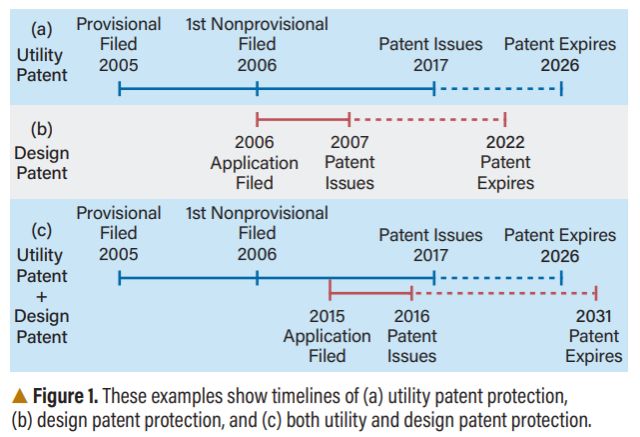When most people think of patents, they naturally think of utility patents. Utility patents claim novel and non-obvious products and processes in words, occasionally using chemical formulas to protect an invention. Sometimes, however, customers will select a product with a more stylish design over the competition, particularly when the utilitarian features are similar among the available options. That's where design patents come in — to protect a product's novel ornamental design rather than its utilitarian features.
A common question is, "Why bother fi ling a design patent application when the product is protected by a utility patent or a utility patent application has been fi led?" For one, utility and design patents protect different aspects of a product. Design patents are not intended to protect anything that is primarily utilitarian, instead they protect the purely aesthetic features of a product. More importantly, perhaps, is that the remedy available for infringement of a design patent can be different from infringement of a utility patent — in at least one case, a billion dollars different.
Damages for utility patents are typically limited to a reasonable royalty, although they can be equal to the patent owner's lost profi ts. Damages for design patents, however, can be the infringer's entire profi t for a product found to infringe a design patent. The difference between those two measures of damages can be quite substantial. For example, in the long-running smartphone litigation between Apple and Samsung, a California jury in 2018 awarded Apple $5 million for Samsung's alleged infringement of two of Apple's utility patents. In contrast, a different California jury in 2012 awarded Apple more than $1 billion for Samsung's alleged infringement of Apple's design patents. While both verdicts were ultimately vacated and the cases settled, the comparison demonstrates the value of design patents and why they should be considered for any intellectual property (IP) strategy.
Design patents have another difference: their term of protection — 15 years — is tied to their date of issuance

20 years from the fi ling date of the earliest non-provisional application to which the patent claims priority, as is the nominal term for utility patents. While 15 years may not seem as long of a term as 20 years, integrating protection from both utility and design patents in an IP protection plan makes a difference in when that clock begins ticking. The following example illustrates this point by looking at three hypothetical cases: using a utility patent alone, using a design patent alone, and using both types of patent protection.
- Utility patent protection. The fi rst hypothetical assumes that an inventor fi led a provisional application in 2005 and a non-provisional utility application a year later in 2006. Next, after signifi cant prosecution and fi ling several continuation and divisional applications, a utility patent issues in 2017. Because a utility patent's term is tied to the fi ling date of the earliest non-provisional application (e.g., 2006), the utility patent would nominally expire in 2026 (Figure 1a), just nine years after the patent was issued.
- Design patent protection. The next hypothetical assumes only a design patent is fi led on the same date as the fi rst nonprovisional utility application in the above example, i.e., 2006. Prosecution for design applications takes less time on average than utility applications, so this example assumes the design patent issues just a year later in 2007. The design patent would then nominally expire in 2022 (Figure 1b).
- Integrated strategy. The third hypothetical assumes that the design patent application is fi led in 2015, claiming priority to one of the pending utility applications. The design patent could issue in 2016 and then expire in 2031 — fi ve years after the utility patent expires in 2026 (Figure 1c).
This last hypothetical thus achieves a longer overall term of protection and a later date for that protection to end than any one individual type of protection alone.
Finally, design patents can be less expensive to obtain in the fi rst place. The American Intellectual Property Law Association's 2021 Report of the Economic Survey reported that the average cost to prepare a design patent application was $2,100 and the average cost to prepare a utility patent application in the chemical arts was $11,657. While this may be an oversimplifi cation as each patented invention is different and the time to prepare an application varies depending on its complexity, it illustrates that design patent protection can both cost less in the fi rst place, and result in higher monetary recovery at the same time. So, if your company is not pursuing an integrated patent strategy that includes design patents, perhaps you should ask your IP counsel, "Why not?"
The content of this article is intended to provide a general guide to the subject matter. Specialist advice should be sought about your specific circumstances.

